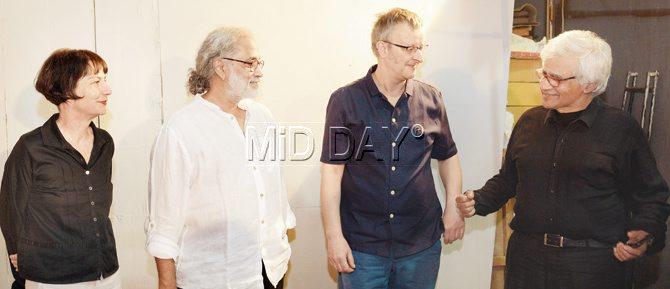An audio-based art project that's en route to Mumbai from Delhi harks back to a forgotten naval mutiny at the Bombay docks in 1946

Valentina Vitali, Ashish Rajadhyaksha, David Chapman and Vivan Sundaram

Meanings of Failed Action: Insurrection 1946 comprises a 40-feet-long aluminium and steel structure inside which an 8-channel audio work will play. Pics/Gireesh GV
ADVERTISEMENT
Some 45 of us are huddled along the sides of a ship. Sirens wail, a beam of light scans the walls. To the tune of Morse code, a voice asks for the telegraph operators and seamen with the Royal Indian Navy to strike. The Empire will go dead silent in half an hour.
A British admiral derisively says that the striking men - the Indian mutineers - have completely lost control of their senses. Sardar Vallabhai Patel, the freedom activist and highest Congress authority of that time, asks the distressed navy men to abandon their protest. More voices, more clamour, more confusion.
 ?
?
Guests seated inside the structure during the preview
Except, this is 2017, not 1946. Except, we are in landlocked Gurgaon, not the Bombay docks. Yet, we have time-travelled in this vessel to a naval mutiny that got sidelined into a footnote by history.
Meanings of Failed Action: Insurrection 1946 is a new work by artist Vivan Sundaram and cultural theorist Ashish Rajadhyaksha that previewed earlier this week in the NCR, ahead of its opening in Mumbai on March 17. The work, played inside a 40-feet-long structure, comprises a mural and a 42-minute-long audio of archival and new recordings, accompanied by controlled light effects, on the Royal Indian Navy (RIN) Mutiny, a five-day-long strike which saw the participation of 80 ships and nearly 20,000 ratings.

Valentina Vitali, Ashish Rajadhyaksha, David Chapman and Vivan Sundaram
Resurrecting the insurrection
When we meet Sundaram, 74, he says, "We wanted to revisit a slice of history, which was largely looked at as a failure, and receive it from today's viewpoint."
If our history textbooks have not amply elaborated on the RIN Mutiny, here are the facts. On February 18, 1946, 1,500 ratings onboard the HMIS Talwar, the second-largest training centre in the British empire, rebelled against the ruling forces on account of the pigsty-like squalor and racism onboard and at the Castle Barracks of the city. The mutiny soon spread to the streets of Bombay and the subcontinent.

The Naval Uprising Statue in Colaba. Pic/BipinâÂu00c2u0080Âu00c2u0088Kokate
A newly-formed Naval Central Strike Committee demanded that the RIN be renamed as the Indian National Navy; the Union Jack was pulled down and the flags of the Congress, the Muslim League and the Communist Party were brandished. "The British were deeply concerned - the Second World War was a messy business that threatened to breed smaller wars, and this mutiny was an interruption they couldn't handle, therefore," says Rajadhyaksha, adding that the Congress and the Muslim League asked for the mutineers to surrender.
An independent India was nearly at hand; an insurgence was the last thing the Freedom Movement needed. "Gandhi took an opposition on philosophical grounds; Nehru's motives were more political; and, the Communist Party supported it but realised this was bigger than what they could handle," he says.
The mutiny ended as a failure in a blood bath. "Attempts by the police to curb public protests left more than 200 dead. That's a tally that ought to be as significant as the Jallianwala Bagh Massacre," says Sundaram.
A different re-telling
At the preview evening, it was not uncommon to hear the constant remarks from guests about how it was "timely" and "relevant". Over samosas and wine, there were those who remembered the ongoing crisis at the JNU campus and the refugee situation across the world.
"The RIN Mutiny is a conundrum we wanted to explore," Rajadhyaksha says. Valentina Vitali, a film historian who has assisted the collaborators, showed us archival telegrams and letters over lunch where the British termed the plight of the ratings as a "mutiny" and "hooliganism"; for the sailors, however, this was an "uprising", one that had as much significance as the Quit India Movement. "There is a communist history, a nationalist history and a series of other histories of this event. And, none of these are enough," Rajadhyaksha adds, evoking academic Leela Gandhi's observation on how this mutiny got "inconsequentialised".
Therefore, an art project. If the whole incident sounds like a heavy-duty political tangle, which it was, the audio-work is itself more poetic than academic. Rather than dissect the RIN Mutiny, it allows for an immersive theatrical experience that captures the mind-boggling complexity of any historical event - there is never just one storyteller. The voice of British officials (sourced from the audio archives at the Imperial War Museum in London) are contrasted with the lyrical empathy of Sahir Ludhianvi's poetry, for instance.
Listening to a 42-minute-long audio piece is as ambitious as making one, more so when there is so much archival material involved. Point this out to the makers and we are told they have entrusted UK-based sound artist, David Chapman with the job. Once Rajadhyaksha and Sundaram had decided on the content, Chapman arranged the piece across eight audio channels. "We have tried to create a narrative, but rather than a linear one, it is more like a collage of voices," says Sundaram.
It's hard to define the experience inside the ship-like micro auditorium. It could be a play that we are watching, except that there are no actors. It could be an exhibit, but, there is nothing to "see". Seated in a circle, immersed in the echoes from history, you are left with nothing to do, except listen.
 Subscribe today by clicking the link and stay updated with the latest news!" Click here!
Subscribe today by clicking the link and stay updated with the latest news!" Click here!






